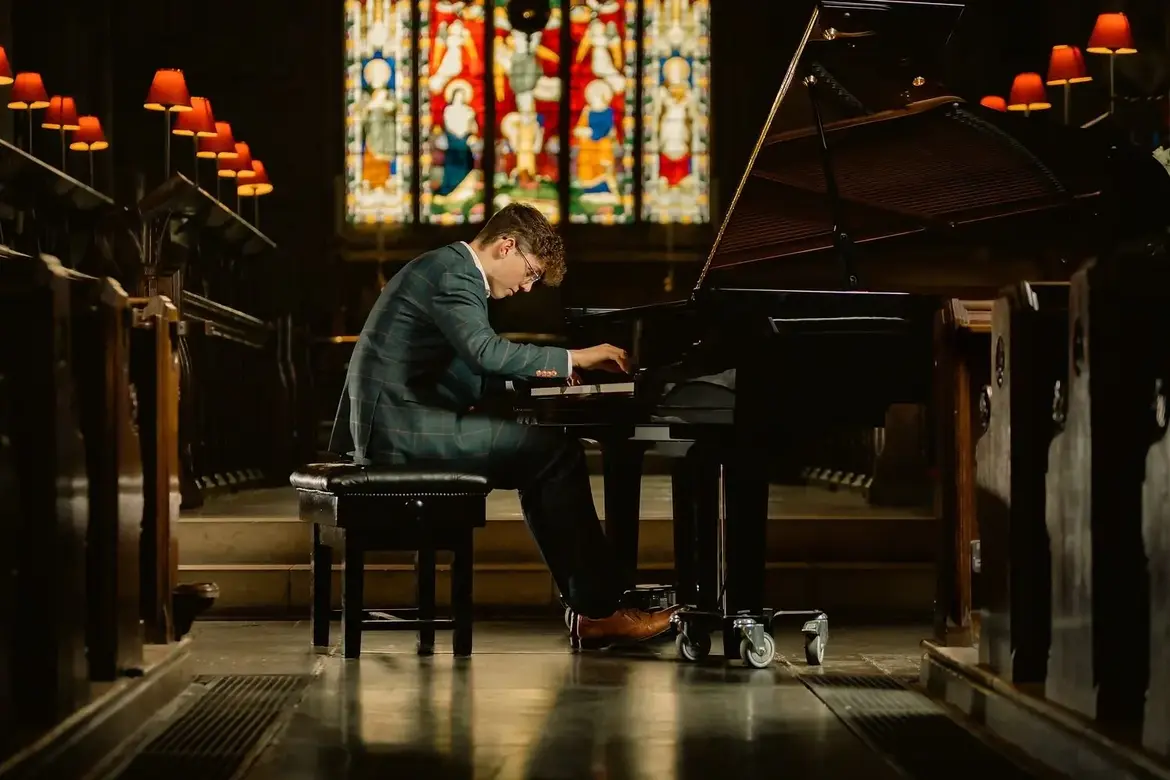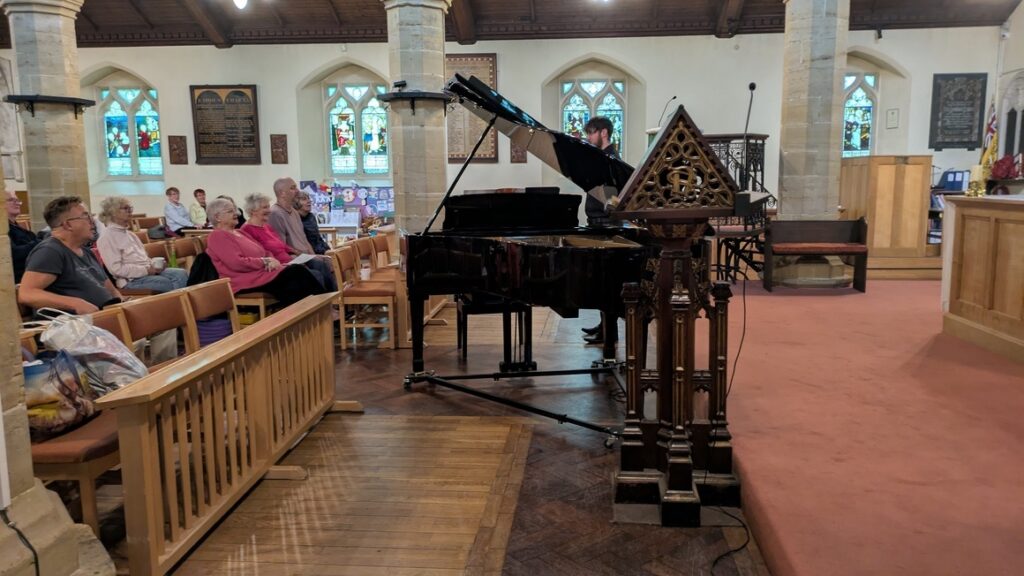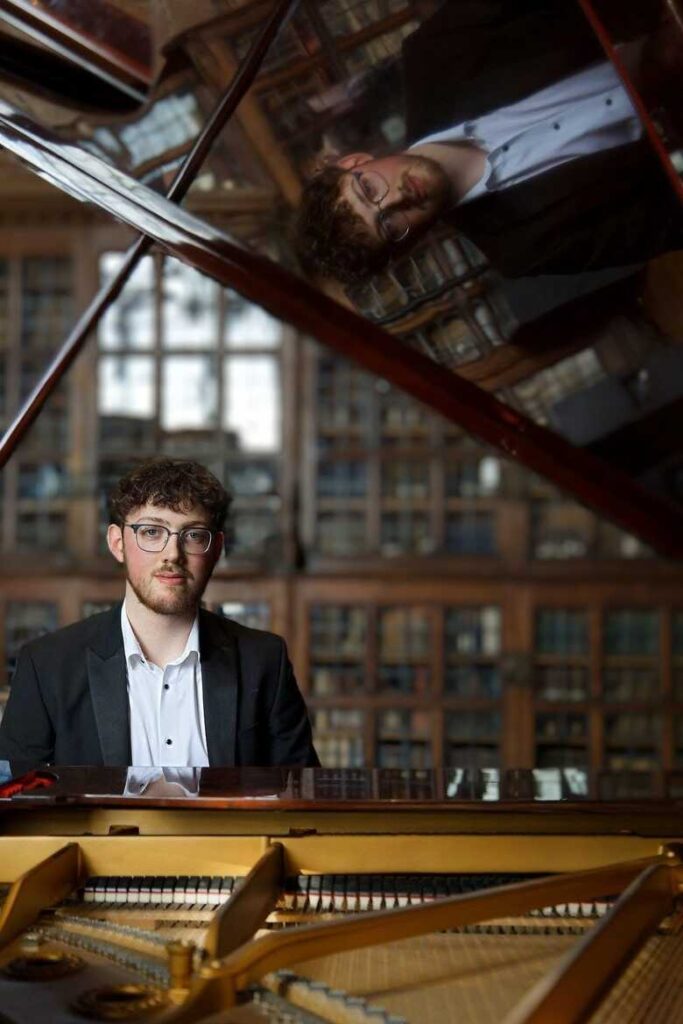Review by Simon Jenner, September 10 2025
Dominic Downs is new to Brighton, this being a second visit to the city and the first at St Nicholas. He plays a recital Kabelevsky, Bach and Beethoven. And a surprise.
A composer conductor and pianist he’s still studying at the Royal Northern College with Murray McLachlan who I assumed had introduced him to some of the repertoire here. I was wrong. Kabalevsky is a composer Downs has played from childhood and explores deeply. Downs has previously been taught by a gallery of pianists including Kathron Sturrock.
He begins in McLachlan Russian Soviet territory and I really hope he continues this vein. Dimitri Kabalevsky (1904-87) has come in for a little of unfair schtick – how he crudely and derivatively follows Prokofiev and Shostakovich and yet dissed them in the Zhdanov crackdown of January 1948. That’s not entirely fair if the man and woefully underrated his vein of lyrical genius. He deserves far more recognition – again.
The Kabalevsky 4 Preludes Op 5 date from around 1926 and are bittersweet lyricism, the kind of slightly jazzy. Lilting and memorably tuneful pieces Prokofiev never wrote because they’re not anything but Kabalevsky (Alexander Tcherepnin does the same and the same appreciation applies).
Sashaying into mild assertiveness, lyrical regret and perky badinage in revolutionary boulevard before the storms of the 1930s, they affirm Downe’ assertion that early Kabalevsky is forward-looking whilst later music of his necessarily echoes the darkness and is more inward. The last ends wide-eyed and looking into a haze of futurity that be er sadly arrived. Downs relishes the tomsl pitch and variety, the cafe insouciance and lyrical Modernism of these delightful miniatures.
Horowitz famously recorded the Piano Sonata No 3 of 1945 but western pianists other than McLachlan have taken up his cuss. Including Kathryn Stott. The discovery of the recital.
Bach’s Partita No 6 in E minor BWV830 id perhaps the most deeply driven of these words though the first two are particularly renowned.
A grand tenebrous opening is also brisk and powerfully-voiced.. sits Toccata touches off with a flourish of E minor dark, the key of grieving. Downs’ pressure exhibits a flicker of organ sonority in his to otherwise light touch. Not at all period performances – few are with Bach – nevertheless a tasteful use of ornamentation
That’s highlighted in the Allemande which follows. Both a wondering yet purposes slowish dance, Downs details this movement as he negotiates its agogic hesitations, originally designed for the harpsichord.
The finale, a Corrente does what it says and “runs” as it must. Even here though the under one of E minor flickers in and out, even whilst there’s a sense of arrival.
A slight hand injury which is pretty undetectable meant a slight change of programme for the last item. In place of Schubert’s four Impromptus D899 we get not something slight but Beethoven’s Tempest Sonata Op 31/2 in D minor. Asked what this dark work meant, Beethoven is said to have referred his friend to Shakespeare’s The Tempest. The last words of the play about being set free might well have chimed with Beethoven’s state if mind around his newly-diagnosed and permanent deafness. The point is more the D Minor in music.
A brooding early-ish masterpiece from around 1802. Its opening phrases of hesitations and repeats, as Beethoven rewinds whole paragraphs of the opening statement. It’s an infusion of doubt expressed. Layers of musical assertion, all somehow falling mute.
The second movement is a major keyed, relief finally, but a kind of ostinato beat on the right hand like a drum tap reminds us we’re still in the realms of inner hearing and doubt.
A set of quiet variations are similarly underpinned. Whilst a new melody in the left hand as ends the heaven of invention with its muse of fire Downs picks this all out in an unhurried mastery.
The obsessive finale – one of Beethoven’s greatest – it played secco by Downs, but allowing the end of phrases to linger in a thespian attitude. Like the Op 57 Appassionata of 1805 this builds though pulse and tempo are relatively steady. Downs’ ratchets up the tension but not the rhetoric so it sears home with a resounding sad yes.
For encore time ‘Tidal Bell’ is one of Downs’ own compositions and sounds at the outset very like late-middle Frank Bridge around 1918.
The piece – written close to where Bridge lived in Eastbourne and where Debussy orchestrated La Mer – is full of maritime away and allusion .it also brings in a heartwarming show tune melody nailing Downs’ firmly as a romantic. Full of sweeping glissando at its climax it’s also a study in chimes and tolling. Raining like ‘La Cathedral Engloutée’ it pitches above the waves before figuratively sinking again. Magnificent.
It’s utterly memorable. And Downs’ is already a very fine communicator. Personable and a true showman as well as virtuoso. I do hope Downs’ goes on to compose in this way. He’s entering the 2027 Leeds Piano Competition with luck and here’s hoping he’ll excel.




